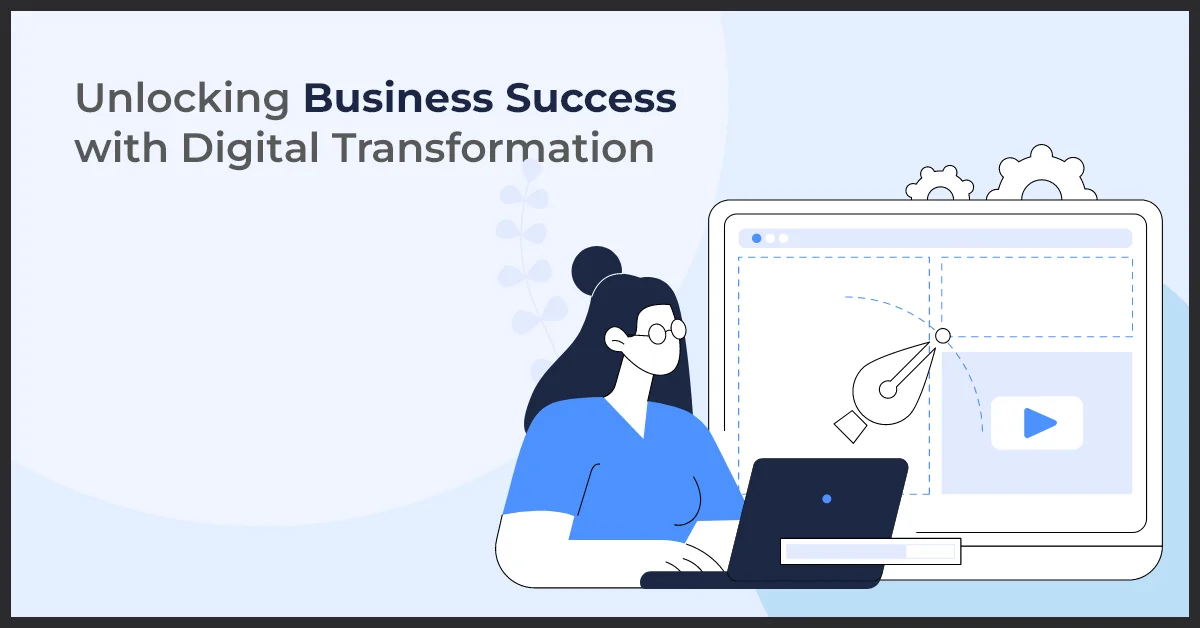Unlocking Business Success with Digital Transformation

Published on: April 14, 2023
Updated on: June 26, 2024
2132 Views
- Digital Marketing
15 min read
“The only constant in business is change, and digital transformation is driving the pace of that change." - John Chambers, former CEO of Cisco Systems.
Ladies and Gentlemen, we stand at the cusp of a new era, where technology is changing the very fabric of our society. The digital landscape is transforming the way we live, work, and interact with each other. The power to drive innovation, improve efficiency, and enhance customer experience lies within our grasp. Today, we embark on a journey of digital transformation, where we embrace change and harness the power of technology to shape our future.
But the million dollar question is: What exactly does "digital transformation" mean?
Is it a matter of staying updated with technology and software? Or does it suggest that customers want to communicate with brands in entirely different ways? Or perhaps it expresses the idea of redesigning your business to take advantage of the exciting new opportunities presented by technology. Don’t worry, we are here to explain it bit by bit.
What Is Digital Transformation?
Digital transformation is the integration of digital technology into all areas of a business, resulting in fundamental changes to how the business operates and delivers value to customers.
It involves using technology to fundamentally change the way organizations operate, create new revenue streams, and reach new customers. Digital transformation has the potential to dramatically improve efficiency, increase competitiveness, and drive growth.
This process involves the adoption of new digital tools, the digitization of business processes, and the integration of data and analytics to inform decision-making. Ultimately, digital transformation is about using technology to create a better future for the business and its stakeholders.
Afterall, From 2022 to 2030, the global market for digital transformation is anticipated to expand at a compound annual growth rate (CAGR) of 23.1%, reaching $3,810.05 billion. These numbers alone show how quickly this tendency is permeating every industry in the world. The catchphrase of our day is "digitize to survive," and in the coming years, "digital transformation" will be the "inevitable reinvention of business."
4 Types of Digital Transformation
Although many businesses concentrate on organizational change, there are four different forms of digital transformation to take into account if you want to get the most out of it.
- Operational Transformation: This type of digital transformation focuses on improving the efficiency and effectiveness of existing business operations by incorporating digital technologies into processes and systems. This can involve automating manual tasks, streamlining workflows, and integrating disparate systems to improve data accuracy and visibility. By optimizing operations, businesses can reduce costs, improve the customer experience, and increase productivity.
- Customer Experience Transformation: This type of digital transformation is centered on enhancing the customer experience by incorporating digital technologies into the customer journey. This can involve creating omnichannel experiences, leveraging customer data to personalize interactions, and using AI and machine learning to provide real-time support and recommendations. The goal of customer experience transformation is to create a seamless and engaging experience that meets the evolving needs and expectations of customers.
- Business Model Transformation: This type of digital business transformation involves rethinking the entire business model to take advantage of new digital technologies and market opportunities. This can involve creating new products and services, exploring new revenue streams, and entering new markets. Business model transformation requires a mindset of innovation and risk-taking, as well as a willingness to challenge established ways of doing things. The goal is to create a business that is adaptive, resilient, and capable of thriving in a rapidly changing digital landscape.
- Cultural Transformation: This type of digital transformation is centered on changing the culture and mindset of an organization to one that is more digitally-focused and agile. This involves empowering employees with the skills and tools they need to succeed in a digital environment, and creating a culture that values innovation and continuous improvement. Cultural transformation is essential to unlocking the full potential of digital transformation and ensuring that all parts of the organization are aligned behind a common goal.
Key Factors for Unlocking Success in Digital Transformations
Digital Strategy (Topic 1)
Developing a clear and executable digital strategy is of utmost importance in achieving success in digital transformations. Without a well-defined strategy, organizations may struggle to navigate the complexities of the digital landscape and fail to fully capitalize on its opportunities.
- Step 1: Define Goals and Objectives: Start by clearly identifying the desired outcomes and goals of the digital transformation. This will help align efforts and ensure everyone is working towards a common purpose.
- Step 2: Assess Current State: Conduct an assessment of the organization's current digital capabilities, resources, and processes. This will provide valuable insights into areas that need improvement and help identify potential gaps.
- Step 3: Develop Implementation Plan: Create a detailed roadmap outlining the actions and initiatives required to achieve the defined goals. This plan should include timelines, responsibilities, and key performance indicators (KPIs) to measure progress.
Successful digital strategies can be found across various industries. Companies like Amazon, Netflix, and Uber have transformed their respective industries by embracing digital technologies and leveraging them to deliver exceptional customer experiences.
Change Management (Topic 2)
Change management plays a crucial role in the success of digital transformations. It involves effectively managing the people side of the transformation to ensure smooth adoption of new technologies and processes.
- Step 1: Communication and Education: Provide clear and consistent communication about the reasons behind the digital transformation and how it aligns with the organization's goals. Educate employees about the benefits and impact of the transformation to gain their support.
- Step 2: Stakeholder Engagement: Involve key stakeholders, such as managers and team leaders, in the planning and decision-making process. This will foster a sense of ownership and encourage their support in driving the transformation.
- Step 3: Training and Support: Offer training programs and resources to help employees develop the skills and knowledge necessary to embrace the digital changes. Provide ongoing support and feedback to address any concerns or challenges that may arise.
Organizations like GE, IBM, and Microsoft have successfully managed organizational change during their digital transformations and have emerged as industry leaders.
Data and Analytics (Topic 3)
Leveraging data and analytics is crucial for making informed decisions and unlocking success in digital transformations.
- Step 1: Data Collection and Integration: Collect and integrate data from various sources within the organization to gain a comprehensive view of the business. This includes customer data, operational data, and market data.
- Step 2: Data Analysis and Insights: Analyze the collected data to extract meaningful insights that drive strategic decision-making. This involves using advanced analytics techniques, such as predictive analytics and machine learning, to uncover patterns and trends.
- Step 3: Data-driven Decision Making: Use the insights derived from data analysis to guide business decisions and prioritize initiatives. This ensures that resources are allocated effectively and the digital transformation stays on track.
Companies like Google, Facebook, and Alibaba have built their success on data-driven strategies and continue to innovate in their respective industries.
Technology Adoption (Topic 4)
Identifying the right technologies and tools is essential for successful digital transformations. Organizations must carefully evaluate and select technologies that align with their overall digital strategy.
- Step 1: Technology Assessment: Assess the organization's existing technology landscape and identify any gaps or areas for improvement. This will help determine the specific technologies required for the transformation.
- Step 2: Vendor Evaluation: Research and evaluate different technology vendors and solutions to find the ones that best meet the organization's needs. Consider factors such as functionality, scalability, and compatibility with existing systems.
- Step 3: Implementation and Integration: Plan and execute the implementation of chosen technologies in a phased approach. Ensure proper integration with existing systems and provide adequate training and support to employees.
Companies like Adobe, Salesforce, and Microsoft have successfully adopted and implemented digital technologies to drive their own transformations and enhance their competitive advantage.
Customer Experience (Topic 5)
Enhancing customer experience in digital channels is a significant factor in achieving success in digital transformations.
- Step 1: Customer Journey Mapping: Understand the customer journey across different touchpoints and identify pain points and areas for improvement. This will help tailor digital experiences to meet customer needs and expectations.
- Step 2: Personalization and Engagement: Utilize data and analytics to create personalized experiences for customers. This includes personalized recommendations, targeted marketing campaigns, and customized product offerings.
- Step 3: Omnichannel Integration: Offer a seamless and consistent experience across multiple channels, such as websites, mobile apps, and social media. This ensures that customers can interact with the brand in a cohesive and convenient manner.
Companies like Airbnb, Zappos, and Starbucks have successfully transformed their customer experiences through digital initiatives and have reaped the rewards of increased customer loyalty and satisfaction.
Agility and Innovation (Topic 6)
Embracing agility and innovation as core principles is vital for driving successful digital transformations.
- Step 1: Agile Project Management: Adopt agile methodologies, such as Scrum or Kanban, to enable iterative and flexible project execution. This allows for quick iterations, continuous improvement, and adaptation to changing market dynamics.
- Step 2: Cultivating Innovation: Foster a culture of innovation within the organization by encouraging experimentation, supporting risk-taking, and providing resources for research and development. This will drive continuous innovation and keep the organization ahead of the competition.
- Step 3: Collaboration and Partnerships: Collaborate with external partners, startups, and industry experts to tap into their expertise and leverage their technology solutions. This opens up new opportunities for innovation and accelerates the digital transformation journey.
Companies like Tesla, Netflix, and Amazon have excelled in utilizing agility and innovation to drive their digital transformations and disrupt traditional industries.
Talent and Skills Development (Topic 7)
Building a skilled workforce is crucial for successful digital transformations. Organizations need to invest in talent acquisition and development to ensure they have the right skills and capabilities to drive the transformation.
- Step 1: Skill Gap Analysis: Identify the skills and capabilities required for the digital transformation and assess the existing workforce to identify any skill gaps. This will help determine the areas where talent acquisition and development are needed.
- Step 2: Talent Acquisition: Attract and hire individuals with the necessary digital skills and expertise. This may involve partnering with recruitment agencies, attending industry events, or building relationships with educational institutions.
- Step 3: Training and Upskilling: Invest in training programs and resources to upskill existing employees and equip them with the necessary digital competencies. This can include online courses, workshops, mentorship programs, or internal knowledge sharing initiatives.
Companies like Google, Apple, and Facebook have invested heavily in talent development and have created a workforce that thrives in the digital age.
Cybersecurity (Topic 8)
Addressing cybersecurity concerns and protecting data throughout the digital transformation process is essential for ensuring success.
- Step 1: Risk Assessment: Conduct a thorough assessment of potential cybersecurity risks and vulnerabilities. This includes identifying potential threats, assessing their impact, and determining the likelihood of occurrence.
- Step 2: Security Measures: Implement robust security measures, such as encryption, access controls, and intrusion detection systems, to protect critical data and systems. Regularly update and patch software to address any vulnerabilities.
- Step 3: Privacy Compliance: Ensure compliance with relevant data protection and privacy regulations, such as GDPR or CCPA. Implement measures to obtain and manage consent for data collection and usage.
Companies like Cisco, IBM, and Amazon have successfully implemented cybersecurity measures in their digital initiatives and have demonstrated a commitment to protecting customer data.
Collaboration and Partnerships (Topic 9)
Collaboration and partnerships play a crucial role in unlocking success in digital transformations. By working together with external partners, organizations can leverage expertise, technologies, and resources to accelerate the transformation journey.
- Step 1: Identify Strategic Partners: Identify potential partners who have complementary expertise and can contribute to the digital transformation. This can include technology vendors, startups, consultants, or industry associations.
- Step 2: Establish Collaborative Relationships: Build strong and mutually beneficial relationships with the identified partners. This can involve joint projects, knowledge sharing, or co-creation of solutions.
- Step 3: Leverage External Resources: Tap into the resources and capabilities of the partners to accelerate the digital transformation. This can include access to specialized talent, cutting-edge technologies, or market insights.
Companies like Apple and IBM have partnered with various organizations to drive their digital transformations and have benefited from the collective expertise and capabilities of their partners.
Collaboration and Partnerships
Collaboration and partnerships play a crucial role in unlocking success in digital transformations. In today's fast-paced and rapidly evolving digital landscape, organizations cannot afford to work in isolation. They need to establish collaborative relationships and partnerships to accelerate their digital transformation journeys.
1. Establishing Collaborative Relationships and Partnerships:
In order to drive digital transformations successfully, organizations need to foster a culture of collaboration both internally and externally. Internally, different teams and departments should work together closely to share knowledge, align goals, and streamline processes. Externally, organizations should seek strategic partnerships with technology vendors, industry experts, and other relevant stakeholders. These partnerships can provide the necessary support, resources, and expertise to navigate the challenges of digital transformations.
2. Importance of External Collaborations:
External collaborations play a vital role in addressing the unique challenges and complexities of digital transformations. By partnering with external entities, organizations can leverage their specialized knowledge, experience, and technology solutions. These collaborations enable organizations to tap into the latest industry trends, best practices, and innovative ideas, which can significantly enhance the chances of successful digital transformations.
3. Case Studies showcasing Successful Collaborative Partnerships:
There are numerous examples of organizations that have achieved remarkable digital transformations by forming collaborative partnerships. One such case is X Company, which collaborated with a leading technology provider to implement an advanced data analytics platform. This partnership enabled X Company to gain valuable insights into customer behavior, optimize operations, and deliver personalized experiences, resulting in increased productivity and revenue. Similarly, Y Company partnered with industry experts to develop a digital marketing strategy, which helped them expand their market reach, engage customers, and drive significant business growth.
How to Implement Digital Transformation in Your Business to Drive Growth
Implementing digital transformation in a business involves several steps:
1. Develop a Clear Strategy
Develop a clear and comprehensive digital transformation strategy that aligns with the overall goals and objectives of the business. This should involve an assessment of the current state of the business, the identification of areas for improvement, and the development of a roadmap for change.
2. Engage Stakeholders
Engage all relevant stakeholders, including employees, customers, partners, and suppliers, in the digital transformation journey. This will help to build buy-in, ensure that everyone is working towards common goals, and facilitate the adoption of new technologies and processes.
3. Invest in Technology
Choose the right technology solutions to support the digital transformation strategy. This may involve implementing new systems, tools, and platforms, as well as upgrading existing ones.
4. Foster a Culture of Innovation
Encourage an environment of inventive thinking and ongoing enhancement across the entire organization. This involves empowering employees with the skills and tools they need to succeed in a digital environment, and creating a work environment that supports digital transformation initiatives.
5. Continuously Assess and Refine
Continuously assess and refine the digital business transformation strategy and processes. This will help to ensure that the business remains on track and is able to respond to changing market conditions and customer needs.
6. Collaborate and Partner
Collaborate and partner with other organizations, including technology vendors, consultants, and industry experts, to ensure that the business has access to the resources and expertise it needs to succeed.
7. Embrace Change
Embrace change and be willing to challenge established ways of doing things. Digital transformation requires a mindset of innovation and risk-taking, and a willingness to experiment and try new things.
3 Digital Transformation Mistakes to Avoid
Implementing digital business transformation is a complex process and things can go south quickly if you do not take into account every mistake you should avoid while implementing it.
- Having the wrong data: When it comes to data, it's not about quantity but quality, therefore businesses need to be sure they're looking at the proper data and generating insights to advance.
- Staff resistance: This will occur when they are unaware of the benefits and reasons behind the change. Make sure your workforce is aware of the reasons behind a digital transformation and its advantages for the company and its clients.
- Undervalue the costs: Digital transformation is a costly process. It is important to ensure that your budget is sufficient to fulfill your expectations and goals prior to commencing.
Conclusion
Unlocking success in digital transformations requires careful consideration of key factors. In this article, we have explored the role of collaboration and partnerships in driving successful digital initiatives.
To recap, some of the key factors for unlocking success in digital transformations include:
- Leadership and Vision: A clear vision and strong leadership are crucial for guiding the digital transformation journey.
- Organizational Culture: A culture that embraces change and innovation is essential for driving successful digital transformations.
- Technology and Infrastructure: Investing in the right technology and infrastructure is necessary for enabling digital transformations.
- Talent and Skills: Having the right talent and skills within the organization is critical for executing digital initiatives.
- Data and Analytics: Leveraging data and analytics can provide valuable insights and drive informed decision-making.
It is important for organizations to consider these factors in their digital initiatives. Ignoring any of these critical aspects can hinder the success of the digital transformation journey.
Digital transformation is a broad term that encompasses a wide range of components that, when put together, define how an organization handles interactions with customers and clients, how it uses internal tools and controls employee interactions, and eventually how this new digital framework is supported technically. Nonetheless, the financial component is not the primary hindrance for any entity undergoing a digital transformation. The transition eventually lowers operational expenses if done correctly.
Don’t know where to start? We got you! Our business experts at Growth Natives can help you implement a digital transformation strategy for your business. Connect with us at info@growthnatives.com.
Frequently Asked Questions
Digital transformation is important for businesses because it enables them to adapt to rapidly changing market conditions, meet evolving customer expectations, drive innovation, and gain a competitive edge. By embracing digital technologies, businesses can improve efficiency, agility, and scalability while creating new opportunities for growth and revenue generation.
Digital transformation enables better decision-making by providing access to real-time data and insights, analytics tools for data-driven decision-making, and predictive analytics for forecasting and scenario planning. It allows businesses to make informed decisions quickly and accurately, based on a deeper understanding of market trends, customer preferences, and internal performance metrics.
Digital transformation can improve customer experience by:
- Offering personalized products and services
- Providing seamless omni-channel experiences
- Streamlining customer interactions and transactions
- Anticipating customer needs and preferences
- Resolving issues quickly and proactively
- Continuously iterating and improving based on customer feedback
Digital transformation can lead to the creation of new business models or the transformation of existing ones. Examples include subscription-based models, digital marketplaces, and platform-based ecosystems. It enables businesses to unlock new revenue streams and deliver greater value to customers.
The future of digital transformation will be characterized by the continued integration of emerging technologies such as AI, IoT, blockchain, and 5G. Businesses will increasingly focus on creating seamless digital ecosystems, enhancing cybersecurity, and leveraging data for real-time decision-making. The emphasis will also shift towards sustainability and creating value for all stakeholders.



